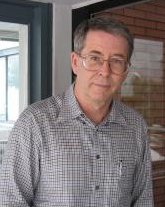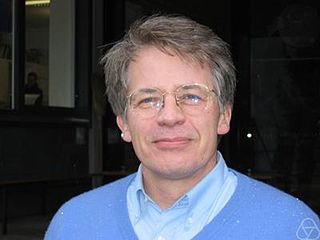Related Research Articles

In mathematics, the classification of finite simple groups is a result of group theory stating that every finite simple group is either cyclic, or alternating, or belongs to a broad infinite class called the groups of Lie type, or else it is one of twenty-six or twenty-seven exceptions, called sporadic. The proof consists of tens of thousands of pages in several hundred journal articles written by about 100 authors, published mostly between 1955 and 2004.

In mathematics, a simple group is a nontrivial group whose only normal subgroups are the trivial group and the group itself. A group that is not simple can be broken into two smaller groups, namely a nontrivial normal subgroup and the corresponding quotient group. This process can be repeated, and for finite groups one eventually arrives at uniquely determined simple groups, by the Jordan–Hölder theorem.

In abstract algebra, a finite group is a group whose underlying set is finite. Finite groups often arise when considering symmetry of mathematical or physical objects, when those objects admit just a finite number of structure-preserving transformations. Important examples of finite groups include cyclic groups and permutation groups.

In mathematics, a sporadic group is one of the 26 exceptional groups found in the classification of finite simple groups.

Richard Dagobert Brauer was a leading German and American mathematician. He worked mainly in abstract algebra, but made important contributions to number theory. He was the founder of modular representation theory.

Daniel E. Gorenstein was an American mathematician. He earned his undergraduate and graduate degrees at Harvard University, where he earned his Ph.D. in 1950 under Oscar Zariski, introducing in his dissertation a duality principle for plane curves that motivated Grothendieck's introduction of Gorenstein rings. He was a major influence on the classification of finite simple groups.

Michael George Aschbacher is an American mathematician best known for his work on finite groups. He was a leading figure in the completion of the classification of finite simple groups in the 1970s and 1980s. It later turned out that the classification was incomplete, because the case of quasithin groups had not been finished. This gap was fixed by Aschbacher and Stephen D. Smith in 2004, in a pair of books comprising about 1300 pages. Aschbacher is currently the Shaler Arthur Hanisch Professor of Mathematics at the California Institute of Technology.

Robert Louis Griess, Jr. is a mathematician working on finite simple groups and vertex algebras. He is currently the John Griggs Thompson Distinguished University Professor of mathematics at University of Michigan.
In mathematical finite group theory, the Thompson subgroup of a finite p-group P refers to one of several characteristic subgroups of P. John G. Thompson (1964) originally defined to be the subgroup generated by the abelian subgroups of P of maximal rank. More often the Thompson subgroup is defined to be the subgroup generated by the abelian subgroups of P of maximal order or the subgroup generated by the elementary abelian subgroups of P of maximal rank. In general these three subgroups can be different, though they are all called the Thompson subgroup and denoted by .
In mathematics, a quasithin group is a finite simple group that resembles a group of Lie type of rank at most 2 over a field of characteristic 2. More precisely it is a finite simple group of characteristic 2 type and width 2. Here characteristic 2 type means that its centralizers of involutions resemble those of groups of Lie type over fields of characteristic 2, and the width is roughly the maximal rank of an abelian group of odd order normalizing a non-trivial 2-subgroup of G. When G is a group of Lie type of characteristic 2 type, the width is usually the rank.
In abstract algebra, the focal subgroup theorem describes the fusion of elements in a Sylow subgroup of a finite group. The focal subgroup theorem was introduced in and is the "first major application of the transfer" according to. The focal subgroup theorem relates the ideas of transfer and fusion such as described by Otto Grün in. Various applications of these ideas include local criteria for p-nilpotence and various non-simplicity criteria focussing on showing that a finite group has a normal subgroup of index p.
In group theory, Bender's method is a method introduced by Bender (1970) for simplifying the local group theoretic analysis of the odd order theorem. Shortly afterwards he used it to simplify the Walter theorem on groups with abelian Sylow 2-subgroups Bender (1970b), and Gorenstein and Walter's classification of groups with dihedral Sylow 2-subgroups. Bender's method involves studying a maximal subgroup M containing the centralizer of an involution, and its generalized Fitting subgroup F*(M).
In group theory, the trichotomy theorem divides the finite simple groups of characteristic 2 type and rank at least 3 into three classes. It was proved by Aschbacher for rank 3 and by Gorenstein & Lyons (1983) for rank at least 4. The three classes are groups of GF(2) type, groups of "standard type" for some odd prime, and groups of uniqueness type, where Aschbacher proved that there are no simple groups.

Bernd Fischer was a German mathematician.
In mathematical finite group theory, a block, sometimes called Aschbacher block, is a subgroup giving an obstruction to Thompson factorization and pushing up. Blocks were introduced by Michael Aschbacher.
In finite group theory, a branch of mathematics, a group is said to be of characteristic 2 type or even type or of even characteristic if it resembles a group of Lie type over a field of characteristic 2.
In mathematical finite group theory, a group of GF(2)-type is a group with an involution centralizer whose generalized Fitting subgroup is a group of symplectic type.
Koichiro Harada is a Japanese mathematician working on finite group theory.
Ronald "Ron" Mark Solomon is an American mathematician specializing in the theory of finite groups.
References
- ↑ "Mathematicians who classified finite simple groups". Archived from the original on September 24, 2011. Retrieved March 28, 2012.
- ↑ Richard Lyons at the Mathematics Genealogy Project
- ↑ Richard Lyons (1972,5) "Evidence for a new finite simple group", Journal of Algebra 20:540–569, and 34:188–189
- ↑ List of Fellows of the American Mathematical Society